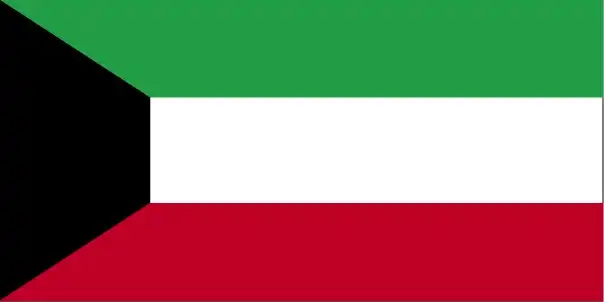Kuwait Flag
National Flag of Kuwait
Kuwait Flag Display

Quick Facts About Kuwait and Kuwait Flag
- Adopted:
- Aspect Ratio:
- 1:2
- Capital:
- Kuwait City
- Population:
- Approximately 4.5 million (2023)
Kuwait Flag Description
The national flag of Kuwait comprises three horizontal bands of green, white, and red with a black trapezoid at the hoist. The acute trapezoid gives the flag a unique shape among global flags and embodies both Pan‑Arab symbolism and historic national resilience.
Symbolism & Meaning of the Kuwait Flag
Green represents fertile land and the future of Kuwait, white symbolizes purity and noble deeds, red stands for the bloodshed defending the nation, and the black trapezoid signifies defeat of enemies and steadfastness. These colors collectively echo the Pan-Arab palette, derived from a 14th‑century poem: ‘White are our deeds, black our battles, green our fields, red our swords.’
Historical Background of the Kuwait Flag
Before independence, Kuwait’s flags evolved from plain red, to versions bearing Arabic inscriptions and religious declarations during the early 20th century. In 1961, following independence from Britain, the current Pan‑Arab design was adopted on 7 September, officially hoisted on 24 November. The intricate trapezoid shape and four-color arrangement mark a break from colonial symbolism.
Design Elements of the Kuwait Flag
The flag displays a 1:2 rectangular format. From hoist to fly: a black acute trapezoid, then horizontal bands of green (top), white (middle), red (bottom). Precise Pantone or Pantone‑equivalent shades are defined in visual identity guidelines. The trapezoid shape is unique in national flags; official design rules specify horizontal vs. vertical orientation.
Usage & Protocol of the Kuwait Flag
Kuwaiti protocol mandates that the green stripe is uppermost when flown horizontally, and the black trapezoid on the left edge if displayed vertically. The flag is used at national holidays such as Independence Day (25 February) and Liberation Day (26 February), flown at sunrise and lowered at sunset, and lowered to half‑mast during mourning. Desecration is prohibited by law and punishable; damaged flags are respectfully retired under legal and social norms.
Frequently Asked Questions
What do the colors of the Kuwait Flag represent?
Green represents fertile land and the future of Kuwait, white symbolizes purity and noble deeds, red stands for the bloodshed defending the nation, and the black trapezoid signifies defeat of enemies and steadfastness. These colors collectively echo the Pan-Arab palette, derived from a 14th‑century poem: ‘White are our deeds, black our battles, green our fields, red our swords.’
When was the Kuwait Flag adopted?
The Kuwait flag was adopted on 7 September 1961 (hoisted 24 November 1961), marking an important milestone in the country's development as an independent nation.
What is the aspect ratio of the Kuwait Flag?
The Kuwait flag has an aspect ratio of 1:2, which determines the proportional relationship between its width and height for official display purposes.